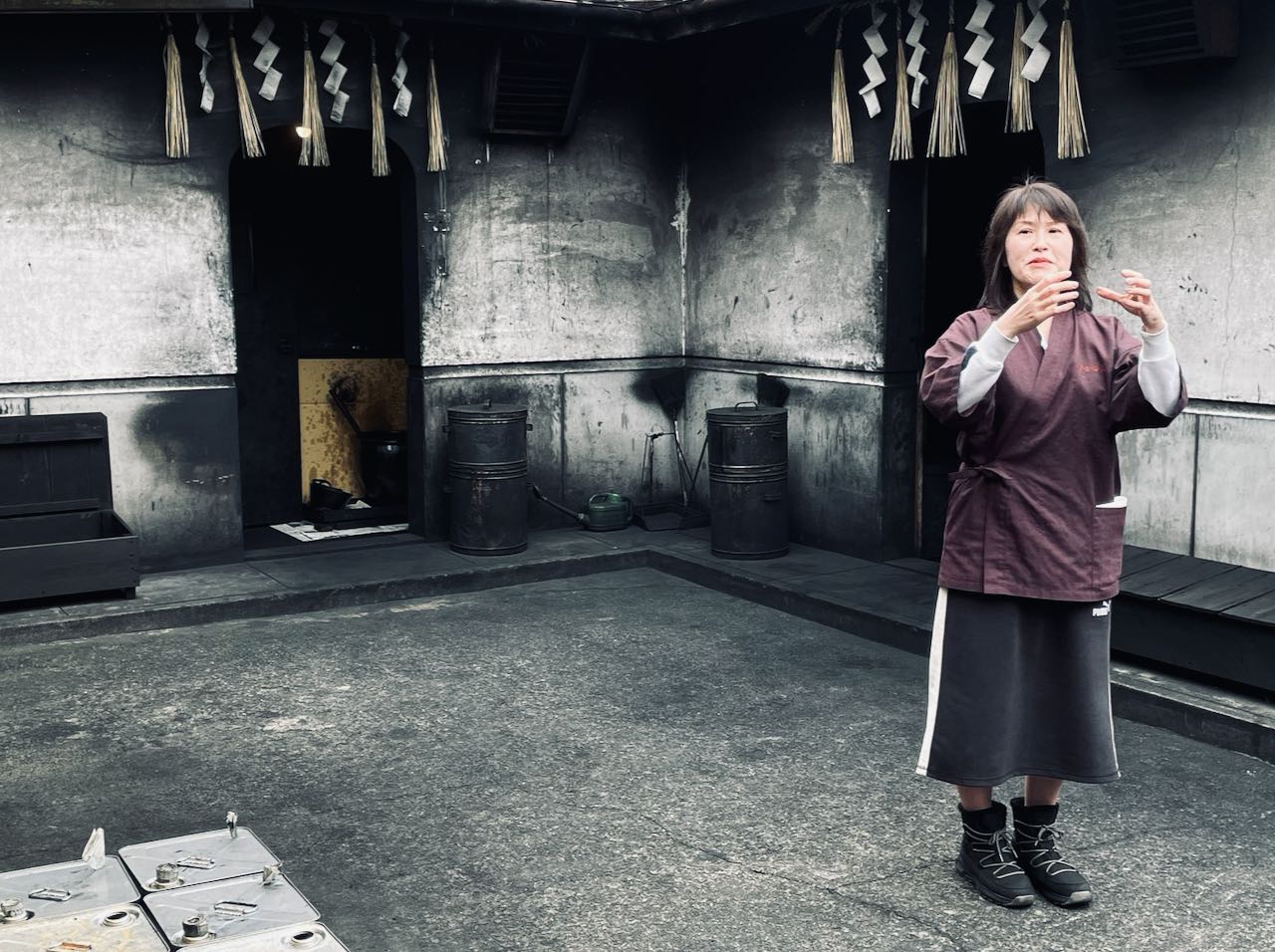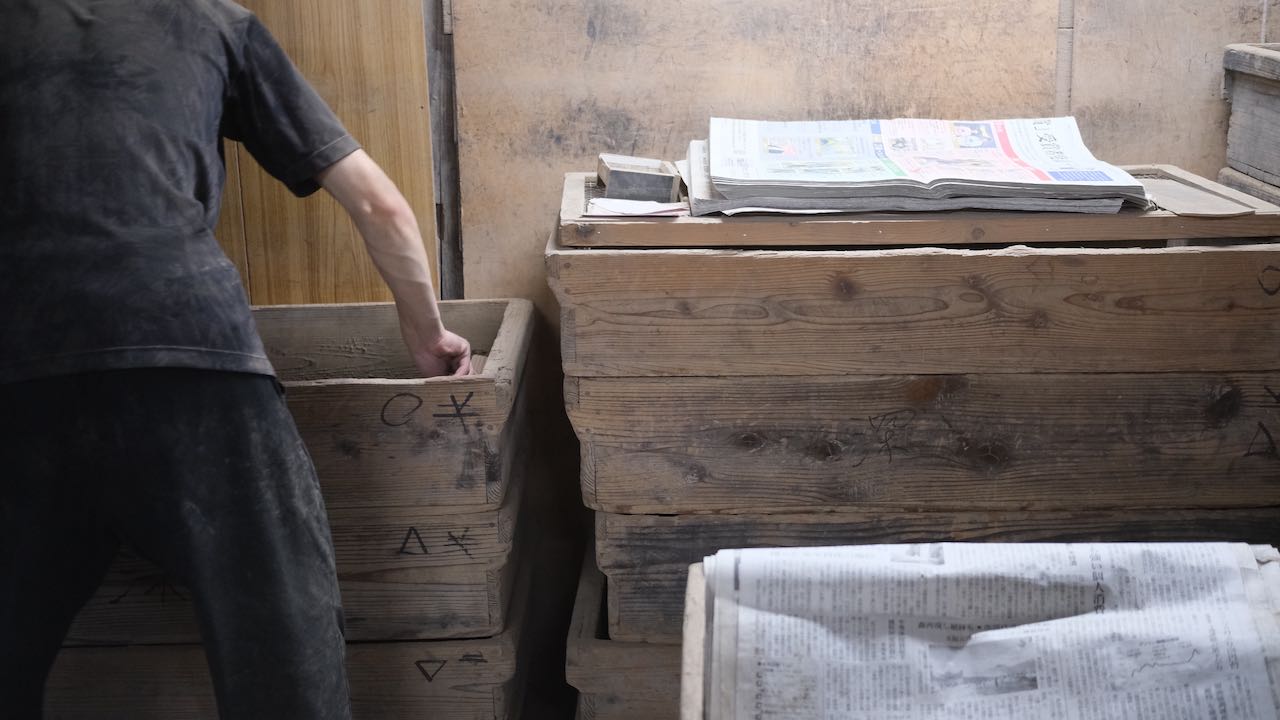My alarm clock is programmed for 8am. At 6am I am loudly woken up. I curse the joker who set the alarm clock for me yesterday
A very Japanese breakfast in the restaurant of the hotel. It was a bit too exotic and a bit too early in the day for my stomach. I try, but don’t finish everything. Before we get started with the day, I rush down to the 7/11 around the corner for a cup of coffee. I am not the only one who needs more than just a cup of green tea to get me going in the morning.
Today’s programme: SUMI. No, no, not SUMO! SUMI is Japanese black ink. Today we are going to visit two companies that are still producing the ink in the traditional way.


The first company,Kobaien, still works according to the original recipe and the original method from the Edo period. Since the 7th generation, the stamp they use on the ‘fancy’ blocks has remained unchanged. The company is now in the hands of the 16th generation of the family. We get a full explanation and learn that the quality of the ink blocks depends on the oil used (camellia or rapeseed), the size of the wick (small wicks burn more slowly and produce finer soot), the quality of the glue (deer, cow or donkey bone glue) and the ambient temperature when the ink is made (January/February are the coldest and best months in Japan). That is a lot of parameters. It’s almost as simple as making woodblock prints!
Anyway. The setting is amazing. The colours and patinas are sublime. I love it. And I’m not the only one who does.



The working conditions, however, are somewhat different. The ash covers everything. A bluish steam hangs around the buildings. You can taste it in your mouth. Yet no one wears a mask or protective clothes. Everything is black, peoples clothing, their arms and feet. They knead the dough with their feet, which is then kept warm by sitting on it. A piece of the dough is taken off each time, weighed out precisely and then rolled out to form a sausage. The ends are neatly closed and pressed into the form.
You can make your own bar of Sumi Ink here. It will be sent to you in a few months. It takes five months to dry. The homemade stick is cool. But the homemade part is slightly overrated. It amounts to holding a soft sausage of ink paste in your hand and squeezing your fingers around it for a moment. Back in Belgium, some weeks later, I regret that I did not make a bar - the result is beautiful. Well, next time then!


The sticks are taken out of the mould and have to harden in wooden boxes, which are packed in a different wooden box every day, between newspaper and centuries-old ashes (which are getting drier and drier). They are then braided into a long rope. They are left to dry for about five months.
Each stick is then sifted, painted with gold leaf, perfumed or polished.


Oh my. Is there anything here in Japan that is easy and quickely made without so much handwork?
We have lunch on the top floor of Nara station. The hospital is on the mezzanine floor of the station. We order our food carefully, enjoying the view. It’s all in Japanese, but it’s the IPad we need to use to order that makes it a little stressful. Hanna from Finland is a vegetarian and is served a soup with large bowls of meat. Courageously, she takes the meat out and drinks the rest of the soup.
In the afternoon we visit Boku’undo. This is a somewhat younger shop.
Here they sell ink paste. Among the mokuhanga people, this has the reputation of being the ‘best of the best’ for black printing. And wow - cheaper than in Tokyo, and they have an even ‘richer’ or blacker version that the colleagues didn’t know about yet.
Shopping is in full swing.
State of affairs with my suitcase: 600g extra. Everyone has the same luggage problems. Someone tells me she has two 23kg suitcases. One of them is just filled with wood.
We train back to Nara. It’s really over now. The fifth Mokuhanga conference has come to an end. Goodbyes are said, invitations are extended, agreements are made and hugs are exchanged. It was nice. I would like to be there the next time it happens. Three years later, wiser, with a fuller portfolio and hopefully a new Flemish Mokuhanga constituency.
Vladimir would like to buy some more paper. We will travel to Karuizawa this evening, to Terry’s Mokuhanga school. Stopover in Osaka to buy paper. The vendor knows Vladimir by now. It’s the third time this trip he’s been there.
We still have four hours of train ahead of us. ETA is 11.30pm. If we miss a transfer somewhere it will be a night in Tokyo.
Exciting it will definitely be. We get off a few stops before Tokyo (too early that is!), in Tokyo our connection seems to be abolished. But all’s well that ends well.
We get off in Karuizawa, and walk to our accommodation where our luggage and made-up beds await us.